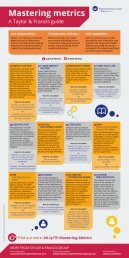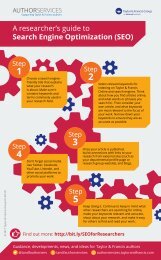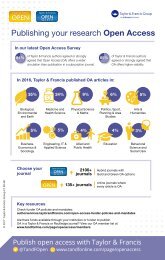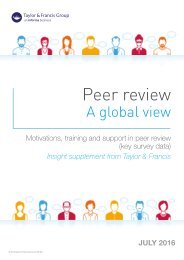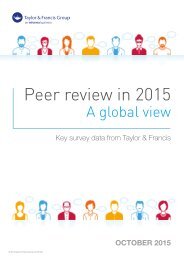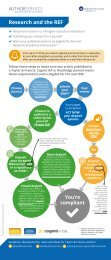White paper
Peer Review in 2015
Peer Review in 2015
Create successful ePaper yourself
Turn your PDF publications into a flip-book with our unique Google optimized e-Paper software.
Realities of submission – feedback timeframe<br />
Data: to review or not to review?<br />
100<br />
75<br />
96% 94% 93% 95%<br />
75%<br />
HSS<br />
STM<br />
When asked about views on peer reviewing the data authors gather and use during their research, there is moderate<br />
support for this in principle. Researchers are fairly balanced on the subject of whether or not it is realistic to expect<br />
authors to make their data available, and show modest agreement that it is unrealistic to expect reviewers to peer review<br />
author data. Although this finding is reflected in the earlier PRC study, that study did see a stronger willingness with a<br />
small majority of reviewers (51%) saying that they would be prepared to review authors’ data themselves.<br />
50<br />
63%<br />
60%<br />
25<br />
44%<br />
Peer review of authors’ data<br />
is desirable in principle<br />
0<br />
% of editors who<br />
consider 2 months<br />
a realistic amount<br />
of time to give for<br />
the initial report<br />
% of reviewers who<br />
manage to deliver<br />
their initial report<br />
within 2 months<br />
% of editors who<br />
are able to return<br />
initial feedback to<br />
authors within<br />
2 months<br />
% of authors<br />
receiving initial<br />
feedback within<br />
2 months of<br />
submission<br />
6.5 6.8<br />
It is unrealistic to expect<br />
authors to make available<br />
their data for peer review<br />
Where’s my <strong>paper</strong>?<br />
Communicating on time<br />
Being kept informed on the progress of an article as it<br />
went through peer review was not something respondents<br />
rated as being handled effectively at the moment. STM<br />
authors scored communication slightly higher with a<br />
mean score of 6.5 out of 10 compared to 5.5 out of 10<br />
for HSS authors. Interestingly, editors and reviewers (who<br />
were also asked to answer this as an author) scored<br />
communication lower across the board, suggesting that<br />
perhaps expectations are higher within this group.<br />
There was strong support, 8 or more out of 10 in<br />
every case, for journals to publish review times, from<br />
submission to publication decision, online.<br />
“When I was a subject editor the<br />
communication between myself and the<br />
main editor was appalling. Editorial boards<br />
and subject editor structures have been<br />
problematic in my experience”.<br />
Editor, Natural History, United Kingdom<br />
“I sent my <strong>paper</strong> two years ago. I was told<br />
it was going to peer review, I didn’t receive<br />
the reviewer comments but I got editor<br />
comments. The way the editor asked me to<br />
tweak it gave me a strong sense that they<br />
wanted me to cite their research. It is still<br />
ongoing, two years and counting.”<br />
Editor, Soil Science, South Africa<br />
5.9<br />
It is unrealistic to expect<br />
peer reviewers to review<br />
authors’ data<br />
5.6<br />
5.9<br />
5.6<br />
All scores are on a scale of 1-10, with 1 being strongly disagree to 10 being strongly agree HSS STM<br />
16 PEER REVIEW IN 2015 A GLOBAL VIEW<br />
THE MECHANICS OF PEER REVIEW 17





